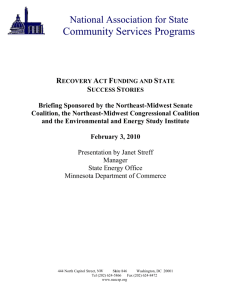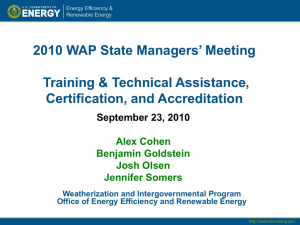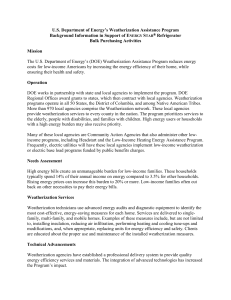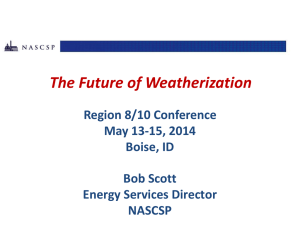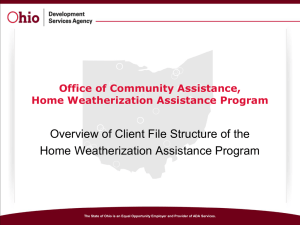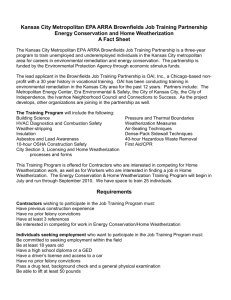2010 WAP State Managers' Meeting Federal Perspectives and Hot
advertisement
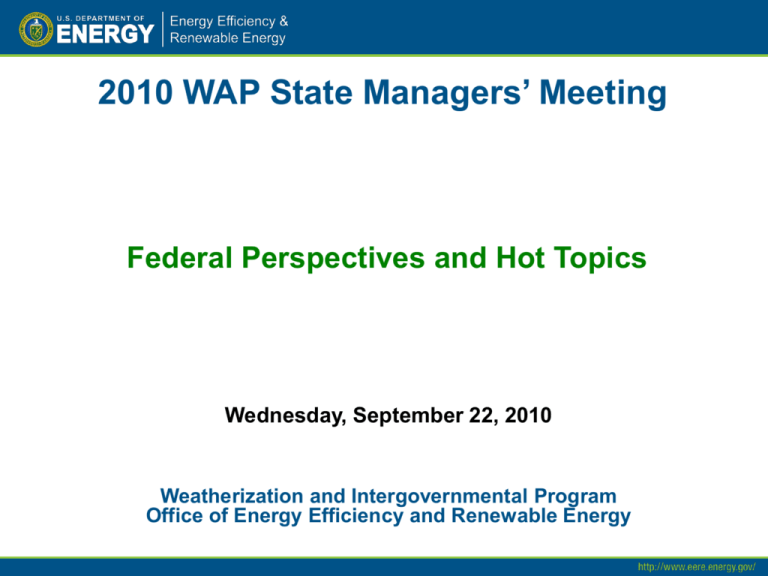
2010 WAP State Managers’ Meeting Federal Perspectives and Hot Topics Wednesday, September 22, 2010 Weatherization and Intergovernmental Program Office of Energy Efficiency and Renewable Energy Grant Guidance Program Year 2010 Weatherization Grant Guidance WEATHERIZATION PROGRAM NOTICE 10-01 EFFECTIVE DATE: December 18, 2009 PURPOSE: To issue grant guidance and management information for the Low-Income Weatherization Assistance Program (Weatherization) for Program Year (PY) 2010. Questions? Jean Diggs Grant Guidance Jean Diggs Program Year 2010 Grant Allocations WEATHERIZATION PROGRAM NOTICE 10-02 EFFECTIVE DATE: December 8, 2009 PURPOSE: To provide final Grantee allocations for preparation and submission of applications for funding of the Low-Income Weatherization Assistance Program for Program Year (PY) 2010. GUIDANCE: Provided funding to the Weatherization Assistance Program for Fiscal Year 2010 in the amount of $210,000,000. This $210,000,000 in funding includes $180 million for the traditional Weatherization, of which $3.3 million was allocated for Headquarters Training and Technical Assistance, and $30 million for an innovative leveraging project. Grant Guidance Jean Diggs Adjustment to Program Year 2010 Grant Allocations WEATHERIZATION PROGRAM NOTICE 10-02A EFFECTIVE DATE: August 24, 2010 PURPOSE: To correct the allocations to add the Inter-Tribal Council of Arizona’s allocation to the final Grantee funding for the Low-Income Weatherization Assistance Program for Program Year (PY) 2010. GUIDANCE: At the time the PY 2010 allocations were issued, the Inter-Tribal Council of Arizona did not qualify for funding. The purpose of this notice is to add the funding to Inter Tribal Council of Arizona. The funding for the Inter-Tribal Council of Arizona does not result in a reduction of any other Grantees funding; however, the funding for the Inter-Tribal Council of Arizona does reduce the State of Arizona’s funding by $69,412. Grant Guidance Jean Diggs Procurement Toolkit CD WEATHERIZATION PROGRAM NOTICE 10-03 EFFECTIVE DATE: October 20, 2009 PURPOSE: To issue the Procurement Toolkit CD to all Grantees, to share with their local agencies, for use in the Weatherization Assistance Program. GUIDANCE: To aid in this endeavor, DOE has commissioned “The Weatherization Procurement Toolkit” to explain the steps to be followed in the procuring of materials and contractors. The toolkit provides examples for illustrative purposes to assist in developing your own solicitation documents as you work toward meeting the goals of the Recovery Act and the DOE Weatherization Program. Grant Guidance Greg Reamy Davis-Bacon/Commercial Labor Rates Weatherization Program Notice 10-04 Effective Date: November 10, 2009 PURPOSE: Provides guidance to grantees and local agencies and/or their contractors under the Weatherization Assistance Program on the determination of the cost-effectiveness of weatherization materials installed in multi-family buildings. GUIDANCE: To address the potential difference in wage rates between high-rise buildings and low-rise buildings when determining cost-effectiveness, DOE is defining installation costs so that local agencies and/or their contractors may use the existing weatherization worker wage categories to calculate the cost of installing each measure, for installation in low-rise as well as high-rise buildings. The actual wage paid for installation in a high-rise building must still be the commercial prevailing wage for each of the disciplines used on the project. This guidance effects only the calculation of cost-effectiveness for the purpose of weatherization materials installed under the Weatherization Assistance Program. Grant Guidance Michael Peterson Release of Hold on Remaining 50% of Obligated Funds Weatherization Program Notice10-05 Effective Date: December 3, 2009 PURPOSE: Provides guidance to Grantees under the Weatherization Assistance Program describing required performance to access remaining 50% of obligated funds. GUIDANCE: Department of Energy will provide Grantees access to the remaining 50% of obligated funds based on the following: 30% of all units estimated to be weatherized in plans are completed Each grantee has fulfilled monitoring and inspection protocols in state plan Grantee is monitoring local agencies at least once a year to determine compliance with administrative, fiscal, and State field policies and guidelines 7 Grant Guidance Michael Peterson Release of Hold on Remaining 50% of Obligated Funds (cont) GUIDANCE (cont): Local quality control efforts are in place At least 5% of the completed units are inspected by Grantee staff during the course of the year Grantees’ progress reports are acceptable, submitted in accordance with grant requirements, including being on time and accurate Monitoring reviews confirm acceptable performance Grant Guidance Michael Peterson Release of Hold on Remaining 50% of Obligated Funds (cont) Hold Released on Remaining 50% of Obligated Funds Alabama Arizona Colorado Hawaii Idaho Illinois Indiana Iowa Kansas Kentucky Maine Maryland Michigan Minnesota Mississippi Montana Nevada New Hampshire New Mexico North Dakota Ohio Oregon South Dakota Tennessee Texas Vermont Washington Wisconsin Wyoming Grant Guidance Michael Peterson Health and Safety WEATHERIZATION PROGRAM NOTICE 10-6 Reserved for Health and Safety Will be discussed further in Health and Safety session on Friday, September 24th. Grant Guidance Greg Reamy Davis-Bacon/Wage Determinations WEATHERIZATION PROGRAM NOTICE 10-7 Effective Date: December 14, 2009 PURPOSE: To issue guidance on implementation of revised Wage Determinations (WD) issued by the Department of Labor (DOL) for Recovery Act funded grants under the Weatherization Assistance Program. GUIDANCE: DOE will amend the WAP Recovery Act grants with States to incorporate the revised WDs. The amendment language in the WAP Recovery Act grants will specify a prospective date when the revised WDs must be incorporated into all subawards and contracts for use by local agencies and contractors. Revised WDs will become applicable when a new task or job order for weatherization construction is issued by the local agency or contractor and, at the beginning of a local agency’s or contractor’s certified payroll period. This approach should provide States, local agencies and their contractors a reasonable amount of time to modify subawards and contracts at each level. Revised WDs should have a minimal impact on States, local agencies and their contractors regarding Recovery Act funded WAP grants. Grant Guidance Bob Adams Privacy of Recipients of Services WEATHERIZATION PROGRAM NOTICE 10-08 EFFECTIVE DATE: FEBRUARY 1, 2010 PURPOSE: To issue guidance for the Low-Income Weatherization Assistance Program (WAP) on maintaining the privacy of recipients. GUIDANCE: This guidance is provided to States or other entities named in the Notification of Grant Award as the recipients of financial assistance under the WAP, including the recently added Territories. States receiving funds under WAP have been receiving numerous requests for information regarding the implementation of programs funded through the ARRA. The information requests range from informal inquiries by local elected officials and other community leaders to requests for specific information about recipients from local and regional press outlets. 12 Grant Guidance Bob Adams Privacy of Recipients of Services (cont) GUIDANCE (cont): DOE will work diligently with any state WAP or local service provider to gather the required information and provide it to the requestor. DOE must comply with all requirements of the Government to protect the privacy interests of individuals who participate in these financial assistance programs. DOE would be legally required, pursuant to 5 U.S.C. 552(b)(6), of the Freedom of Information Act, to keep confidential any specifically identifying information related to an individual’s eligibility application for WAP, or the individual’s participation in WAP, such as name, address, or income information. States and local service providers should extend that same protection to their client records for WAP. States may release information about recipients in the aggregate and which does not identify specific individuals, i.e. the number of recipients in a county, city or a zip code does not compromise the privacy of the recipients. Grant Guidance Katherine Foote Clarifying Monitoring Requirements (Amendment to WPN 09-1B) WEATHERIZATION PROGRAM NOTICE 10-9 Effective Date: January 15, 2010 PURPOSE: To clarify the monitoring requirements contained in Section 4.0 GRANTEE PROGRAM OVERSIGHT (Program Monitoring) of Weatherization Program Notice (WPN) 09-1B, Grant Guidance to Administer the American Recovery and Reinvestment Act of 2009 Funding, dated March 12, 2009. The provisions of this guidance apply to States or other entities named in the Notification of Grant Award as the recipients of financial assistance under the Department of Energy (DOE) Weatherization Assistance Program, including the recently added Territories. Grant Guidance Katherine Foote Clarifying Monitoring Requirements (cont) PREVIOUS LANGUAGE 4.0 GRANTEE PROGRAM OVERSIGHT (Program Monitoring) The comprehensive monitoring must include review of client files and subgrantees records, as well as inspection of at least 5 percent of the completed units or units in the process of being weatherized. AMENDED LANGUAGE 4.0 GRANTEE PROGRAM OVERSIGHT (Program Monitoring) The comprehensive monitoring must include review of client files and subgrantees’ records, as well as inspection of at least 5 percent of each subgrantee’s DOEfunded completed units. Grantees are encouraged to review units in the process of being weatherized when monitoring, as well. If inspection reveals quality control or other problems, Grantee shall increase the number of units monitored and frequency of inspection until all issues are resolved. Grant Guidance Carole Gates Reprogramming Training and Technical Assistance Funds to Program Operations WEATHERIZATION PROGRAM NOTICE 10-10 EFFECTIVE DATE: May 25, 2010 PURPOSE: To provide guidance to Grantees when requesting to reprogram Training and Technical Assistance (T&TA) funds to the Program Operations line item. GUIDANCE: Before any Grantee decides to reprogram T&TA funds to Program Operations the following considerations should be made: 1. Based on the statewide average cost per home at which the Grantee is currently operating, the Grantee has enough labor trained to meet the production indicated; 2. The Grantee has reviewed and made certain that the capacity to expand current production levels of homes weatherized can be attained; 3. In adjusting production schedules, Grantees are reminded that all ARRA funds are expected to be expended by March 2012; Grant Guidance Carole Gates Reprogramming Training and Technical Assistance Funds to Program Operations (cont) GUIDANCE (cont): 4. That the Grantee has given consideration to using a portion of their T&TA funds for necessary national evaluation support as Grantees will likely need to hire a local person to conduct activities to help gather information data needed to support the national evaluation effort; 5. That the Grantee has sufficient T&TA funds to assist subgrantees in responding to the regular and ARRA program evaluations; and 6. There are sufficient funds to conduct monitoring visits if a Grantee uses T&TA funds to accomplish monitoring requirements. If after these considerations, a Grantee would like to re-program more than ten percent of their T&TA funds to Program Operations, they will need to do an amendment to their ARRA State plan. This amendment should address the issues outlined above and would require a new production schedule. Additionally, Grantees should be aware that once T&TA funds are re-programmed into the Program Operations budget category they cannot be re-programmed back into T&TA funds at a later date. Grant Guidance Joel Eisenberg National Evaluation WEATHERIZATION PROGRAM NOTICE 10-11 Effective Date: November 10, 2009 Last evaluation done two decades ago In 2004, OMB recommended to DOE that this evaluation be done (see http://www.gao.gov/htext/d0667.html) Process to design this evaluation began in 2005 A national Weatherization Network Committee provided guidance for this evaluation DOE tasked ORNL with conducting evaluation for PY’s 07 & 08 in Spring 2009 PY 07 was chosen to provide DOE and OMB timely energy savings estimates Some components of this evaluation now overlap with the ARRA period This evaluation is now fully funded with ARRA money This evaluation provides important baseline information Status of National WAP Evaluations Retrospective Evaluation Project Team Oak Ridge National Laboratory – Bruce Tonn, Project Manager – Joel Eisenberg, Program Manager Apprise – Principle Subcontractor – David Carroll, President – Jacqueline Berger, Director of Program Evaluation Other Members of Subcontractor team include: – Energy Center of Wisconsin – Michael Blasnik & Associates – Dalhoff Associates, LLC Joel Eisenberg Status of National WAP Evaluations Evaluation Components Process Evaluation Inputs -Funding -Staffing -Training -Client Ed -QA -Regulations Impact Evaluation Outputs Outcomes -Weatherization Jobs Completed -Staff Trained -Clients Educated -Energy Savings -Non-Energy Benefits Joel Eisenberg Status of National WAP Evaluations Joel Eisenberg Process Evaluation Questions What happened in PY 2008 and what happened under ARRA? How did the national weatherization network operate? What were its strengths and weaknesses? How were DOE’s grants to states leveraged with other sources of funding? How were weatherization staff trained? Grantees and subgrantees are being asked to complete comprehensive surveys Status of National WAP Evaluations Joel Eisenberg Expected Timelines for Energy Savings Estimates Data Collection Stages I Retro PY(s) WX Period(s) 07 04/07-06/08 National Data Energy Cleaning Savings and Analysis Estimate Contact Subsampled Subgrantees Contact Utilities 8/10 10/10 5/11 9/11 2/12 08 04/08-06/09 09 04/09-06/10 7/11 10 04/10-06/11 7/12 9/12 3/13 7/13 9/13 4/14 II ARRA III ARRA IV ARRA 11 04/11-06/12 Status of National WAP Evaluations Joel Eisenberg Retrospective Evaluation Status This project is on-going OMB approved an emergency ICR in April 2010, which allows six months of data collection ORNL’s team is actively collecting data The 60-day Federal Register Notice, a first step to having the ICR extended another three years, was published June 9, 2010 to extend data collection period ORNL is trying to finalize OMB approval Status of National WAP Evaluations Additional Analyses Cost effectiveness Non-energy benefits – Utility, household, societal levels Explanatory factors – Measures – Unit characteristics: type, age, size, location – Audit and inspection methods/processes – Climate – ………. Joel Eisenberg Status of National WAP Evaluations Joel Eisenberg Indoor Air Quality Study ~500 weatherized homes, ~ 250 control homes (originally 309 weatherized homes, 59 controls) Nationwide sample of agencies, homes selected randomly from those available Performed during winter (closed homes), perhaps summer in deep south High radon areas will be over-sampled Comparative pre- and post-weatherization sampling periods This study is getting a good deal of attention: CIAQ, EPA, etc. Status of National WAP Evaluations Joel Eisenberg WAP ARRA Period Evaluation: Additional Tasks Sustainable Energy Resources for Consumers Weatherization Innovation Pilot Program Weatherization energy savings persistence Social network study Deferral (walk away) study Public housing; territories GHG emissions/voluntary carbon markets at agency-level Status of National WAP Evaluations Joel Eisenberg Retrospective Evaluation – A Few Preliminary Results for PY 2008 DOE Units/Total Units Weatherized = 49% (n=570) Subgrantee sources of leveraged funding (n=424) – LIHEAP 82%; Utilities 51%; Other state programs 21%, etc. Subgrantee funding (n=438) – DOE $124M; Leveraged funding $242M Subgrantee use: priority lists vs. calculation procedures (n=806) – Priority lists 46%; Calculation 31%; Both 16%; Other 7% Most popular client education approaches (n=804) – In-person instruction at time of inspection 76% – In-person instruction at time of audit 75% Grant Guidance Holly Ravesloot Historic Preservation WEATHERIZATION PROGRAM NOTICE 10-12 Effective Date: FEBRUARY 11, 2010 PURPOSE: To provide guidance regarding the National Historic Preservation Act (NHPA or “the Act”), 16 U.S.C. 470 et seq. This guidance relates to DOE Grantees of the Weatherization Assistance Program for Low-Income Persons (WAP), the State Energy Program (SEP), and the Energy Efficiency and Conservation Block Grant (EECBG) GUIDANCE: DOE coordinates with the Advisory Council on Historic Preservation (ACHP) and the National Conference of State Historic Preservation Officers (NCSHPO). NCSHPO has developed a Prototype Programmatic Agreement to address historic preservation requirements for WAP, SEP and EECBG. 28 Grant Guidance Holly Ravesloot Historic Preservation (cont) GUIDANCE (cont): A manageable framework for streamlining compliance with the requirements of the Act while ensuring the protection of the Nation's historic properties On February 5, 2010, ACHP released the Prototype Programmatic Agreement (Prototype PA) for use by DOE, State Energy Office Grantees and individual SHPOs to address historic preservation requirements The Prototype PA allows flexibility between States while recognizing that many States have already instituted effective consultation protocols that can be applied to DOE's programs Through this Prototype PA, a categorical approach to streamline reviews and reduce the heavy burden placed on SHPOs should expedite the obligation of Recovery Act funds Holly Ravesloot Grant Guidance Historic Preservation Programmatic Agreements Fully Executed PAs In Process PAs Forthcoming PAs Alabama Arizona California District of Columbia Florida Georgia Hawaii Illinois Iowa Kansas Louisiana Maryland Massachusetts Michigan Minnesota Missouri Montana Nebraska Nevada New Hampshire New Mexico North Carolina Ohio Oklahoma Puerto Rico South Carolina South Dakota Texas Utah Virginia Washington Wisconsin Wyoming Delaware Alaska Arkansas Colorado Connecticut Kentucky Maine New Jersey New York North Dakota Pennsylvania Tennessee Vermont Virgin Islands West Virginia Grant Guidance Christine Askew ARRA Reporting Requirements: OMB Quarterly and DOE Monthly Reporting Requirements WEATHERIZATION PROGRAM NOTICE 10-13 Effective Date: March 1, 2010 PURPOSE: To provide guidance to Weatherization Assistance Program (WAP) Grantees on the Office of Management and Budget (OMB) quarterly reporting requirements and the Department of Energy (DOE) monthly reporting requirements related to funds expended under the American Recovery and Reinvestment Act of 2009 (ARRA). The provisions of this guidance apply only to WAP funds provided through ARRA and do not apply to the nominal WAP reporting requirements outlined in the Program Year 2010 Weatherization Grant guidance (WPN 10-01). GUIDANCE: WAP Grantees are required to: 1. Report Section 1512 data to OMB quarterly 2. Report required data to DOE quarterly and monthly 3. Summarize the timing and process relationship between OMB and DOE reporting requirements Grant Guidance Christine Askew ARRA Reporting Requirements (cont) Quarterly Reporting to OMB via FederalReporting.gov Who is Required to Report? Prime recipients of ARRA funds under the WAP Program. A prime recipient is defined as a non-federal organization receiving Recovery Act funding (grants, loans, or cooperative agreements) directly from the Federal Government and is equivalent to a Grantee for the purposes of this guidance. Reporting Timeframe and Registration The report to FederalReporting.gov is due no later than ten calendar days after the calendar quarter in which the recipient received this grant and subsequent quarters until full expenditure of funds. Quarterly and Monthly Reporting to DOE Quarterly Reporting The deadline for reporting these quarterly metrics will be the on the 30th of the month following the close of the quarter for which data is being reported. Monthly Reporting Monthly reports will be due on the 30th of the month following the month for which data is being reported. Grant Guidance ARRA Reporting Requirements (cont) Christine Askew Reporting to DOE: Guidance and Process Christine Askew WAP Reporting: Jobs Job metrics Department of Energy •Hours worked (Recovery Act funds) DOE: 260 Hours Office of Management and Budget (FR.gov) •Full Time Equivalents (Recovery Act funds) OMB: 0.5 FTE (assume 520 hours in quarterly full-time schedule) What jobs do I report? Report only direct jobs worked in the reporting quarter. Direct jobs are those jobs where wages are paid through Recovery Act funds. How far down do I count jobs? From OMB Memorandum 10-08: “To the maximum extent practicable, information should be collected from all sub-recipients and vendors in order to generate the most comprehensive and complete job impact numbers available.” Forthcoming WAP Recovery reporting guidance (WPN 10-13A) removes the requirement to report hours worked through non-federal funds Reporting to DOE: Guidance and Process Christine Askew WAP Reporting: Programmatic metrics Reported at the WAP grantee level •Outlays (Recovery Act funds) •Total units weatherized (excluding re-weatherized) •Total re-weatherized units Reported monthly for expenditures during the months and units completed in the month Reported at the sub-grantee level (by the Grantee) •Total units weatherized Reported monthly units completed in the month •Outlays (Recovery Act funds) Reported quarterly for expenditures by the CAA during the quarter Reporting to DOE: Guidance and Process Christine Askew WAP Reporting: Financials & Units Reported for units completed during the quarter Units by type (e.g. single family, multi-family) -Should be equal to the sum of the 3 monthly reports of total units (excluding re-weatherized) Re-weatherized units -Should be equal to the sum of the 3 monthly reports of re-weatherized units Leveraged units Units by Primary Heating Fuel -Should be equal to the sum of the 3 monthly reports of total units (excluding re-weatherized) Units by Occupancy Total People Assisted with Grant Funds Total Outlays by function Reporting to DOE: Guidance and Process Questions? Christine Askew Grant Guidance Bob Adams Calculation of Job Creation through DOE Recovery Act Funding WEATHERIZATION PROGRAM NOTICE 10-14 EFFECTIVE DATE: March 11, 2010 PURPOSE: Provides additional guidance to grantees on the methodology for calculating jobs created and retained through expenditure of grant funds received under the American Recovery and Reinvestment Act of 2009 (Recovery Act), and reporting that information to the Department of Energy (DOE). GUIDANCE: In accordance with Section 1512 of the Recovery Act, The Office of Management And Budget requires the recipients of Recovery Act grants to report quarterly on direct jobs created or retained (in FTEs) through Recovery Act funds via the website FederalReporting.gov. OMB guidance for reporting under Section 1512 requires that recipients report only those jobs directly generated wholly or in part by Recovery Act funds, excluding those jobs generated from nonfederal funds. Grant Guidance Greg Reamy Final Rule on Amending Eligibility Provisions to Multi-family Buildings WEATHERIZATION PROGRAM NOTICE 10-15 EFFECTIVE DATE: March 2, 2010 PURPOSE: To issue guidance on implementing recent changes to the Weatherization Assistance Program (WAP) requirements for determining eligibility. This applies to certain multi-family buildings identified by the Department of Housing and Urban Development (HUD) and the Department of Agriculture (USDA). GUIDANCE: WHAT DOES THE FINAL RULE DO? DOE has posted three lists of properties supplied by HUD and USDA Properties identified on these lists have been determined to meet certain eligibility criteria under WAP The lists will reduce the review and verification necessary to weatherize the buildings identified through WAP Grant Guidance Greg Reamy Final Rule on Amending Eligibility Provisions to Multi-family Buildings (cont) Requirements of the final rule: A minimum of 66% of the dwelling units in the building are occupied by a family unit that meets the income requirement (as required under 10 CFR 440.22(b)(2) For a reasonable period of time after weatherization work has been completed, the eligible dwelling unit will not be subject to rent increases as a result of weatherization (as required under 10 CFR 440.22(b)(3)(i)) No undue or excessive enhancement has occurred to the value of the dwelling unit (as required under 10 CFR 440.22(b)(3)(i) Grant Guidance Greg Reamy Guidance Regarding Accrual of Benefits to LowIncome Tenants in Multi-Family Buildings WEATHERIZATION PROGRAM NOTICE 10-15A EFFECTIVE DATE: April 8, 2010 PURPOSE: To issue guidance for Grantees on establishing procedures to ensure that the benefits of weatherization assistance in connection with multi-family buildings comprised of rental units will accrue primarily to the low-income tenants residing in such units. GUIDANCE: Under the WAP regulations, a Grantee must ensure that for multi-unit buildings the benefits of weatherizing a building that consists of rental units, including rental units where the tenant pays for energy through rent, accrue primarily to the low-income tenants. (42 U.S.C. 6863(b)(5)(A); 10 CFR 440.22(b)(3)(i)). Grant Guidance Greg Reamy Guidance Regarding Accrual of Benefits to LowIncome Tenants in Multi-Family Buildings (cont) GUIDANCE (cont): Benefits that could be combined, include, but are not limited to: longer term preservation of the property as affordable housing; continuation of protection against rent increases beyond that required under the WAP regulations (10 CFR 440.22(b)(3)(ii)); Investment of the energy savings in facilities or services that offer measurable direct benefits to tenants; Investment of the energy savings from the weatherization work in specific health and safety improvements with measurable benefits to tenants; Improvements to heat and hot water distribution, and ventilation, to improve the comfort of residents; and Establishment of a shared savings programs. Grant Guidance Rob DeSoto Clarification on Selection of Types of Insulation Materials Allowable for Use in WAP WEATHERIZATION PROGRAM NOTICE 10-16 EFFECTIVE DATE: May 26, 2010 PURPOSE: To provide clarification on the types of insulation allowable for use in the Weatherization Assistance Program (WAP). GUIDANCE: DOE reminds State and local agencies, training centers, and all recipients of DOE funds that all types of insulation materials listed in Appendix A are permissible under the program regulations. All current and future written materials, training materials, websites, etc., should reflect the generic reference to insulation materials. All recipients of DOE funds should refrain from making singular reference to any product type when describing an insulation material. Grant Guidance Rob DeSoto Clarification on Selection of Types of Insulation Materials Allowable for Use in WAP (cont) GUIDANCE (cont): If a reference is used, then every type of insulation material must be included in the example so that no preference is displayed for one product type over another. Grantees are reminded of the rules governing the procurement of building insulation products and materials containing recovered materials. Specifically, the Comprehensive Procurement Guideline (CPG) program is authorized by Congress under Section 6002 of the Resource Conservation and Recovery Act (RCRA) and Executive Order 13423. The Environmental Protection Agency (EPA) is required to designate products that are or can be made with recovered materials, and to recommend practices for buying these products. Once a product is designated, procuring agencies are required to purchase it with the highest recovered material content level practicable. Grant Guidance Bob Adams Guidance on Using Non-Federal Resources as a Buydown for Meeting the Saving-To-Investment Ratio for Materials Used in WAP WEATHERIZATION PROGRAM NOTICE 10-17 EFFECTIVE DATE: July 26, 2010 PURPOSE: To issue guidance for State and local agencies to assist them in determining how to compute savings to investment ratios in accordance with 10 CFR 440.21 when determining weatherization measures to be installed on eligible dwelling units where federal and non-federal resources are available for the Weatherization Assistance Program (WAP). GUIDANCE: This guidance is specifically designed to address the DOE investment in eligible dwelling units weatherized by the Program. All associated health and safety costs incurred on a dwelling unit are generally treated outside the SIR when determining cost effectiveness. Grant Guidance Bob Adams Guidance on Using Non-Federal Resources as a Buydown for Meeting the Saving-To-Investment Ratio for Materials Used in WAP(cont) GUIDANCE (cont): When performing the energy audit on an eligible dwelling unit, the total costs associated with the installation of eligible measures – as listed in Appendix A - can be discounted by the amount of non-Federal resources leveraged for that particular measure in determining the SIR. The types of non-Federal resources that could be used would include, but are not limited to: landlord contributions, utility funds, donations from private sources, and/or state resources that supplement other similar funds. It is DOE’s intent to allow subgrantees some flexibility in calculating the SIR for a specific measure when other funds can be used to offset some of the costs, thereby reducing the federal investment and raising the SIR to 1.0 or greater on the remaining investment. Grant Guidance Bob Adams Guidance on Using Non-Federal Resources as a Buydown for Meeting the Saving-To-Investment Ratio for Materials Used in WAP (cont) GUIDANCE (cont): The cost-effectiveness of the WAP will still be calculated on the total DOE investments used to weatherize the property. It is not DOE’s intent to create projects that are not cost effective in design and installation. DOE expects that all subgrantees will use this SIR calculation allowance only when the cost effectiveness for the entire investment in the property can still be substantiated. Further, it is not DOE’s intent to “leapfrog” measures that are already cost-effective in order to accommodate a measure that is included in the package of measures as a result of utilizing the provisions of this guidance. Grant Guidance Bob Adams Guidance on Using Non-Federal Resources as a Buydown for Meeting the Saving-To-Investment Ratio for Materials Used in WAP (cont) GUIDANCE (cont): All measures that were cost-effective after the initial energy audit is conducted would remain a part of the list of measures to be completed on the unit. Those agencies that have non-Federal resources for use in the building will need to run the energy audit a second time with the necessary resources for any specified measure(s) to ensure the total package of measures remain at least with an SIR of 1.0 or greater. A second energy audit run can be eliminated by indicating what measures will need to utilize this flexibility and the amount of funds necessary to accomplish the buydown. Subgrantees will also be required to complete a summary of all costs associated with the weatherization of the building, including any or all non-Federal resources to be used. This summary will become part of the building’s customer file along with the inputs and results of both energy audits. Grant Guidance Christine Platt Patrick Program Year 2010 Poverty Income Guidelines and Definition of Income WEATHERIZATION PROGRAM NOTICE 10-18 EFFECTIVE DATE: TBD Will be released by September 30, 2010. Grant Guidance Benjamin Goldstein Guidance on the Buy American Provisions EFFECTIVE DATE: March 11, 2010 PURPOSE: Provides guidance to financial assistance recipients regarding Buy American Recovery Act provisions under projects funded by the American Recovery and Reinvestment Act of 2009 and administered by the Office of Energy Efficiency and Renewable Energy (EERE). Grant Guidance GUIDANCE: The Buy American provision in the American Recovery and Reinvestment Act of 2009 (section 1605 of Title XVI), provides that, subject to three listed exceptions, none of the funds appropriated or otherwise made available by the Act may be used for a project for the construction, alteration, or repair of a public building or public work unless all the iron, steel, and manufactured goods used are produced in the United States. The law also requires that this prohibition be applied in a manner consistent with U.S. obligations under international agreements. Grant Guidance Benjamin Goldstein Guidance on the Buy American Provisions (cont) RECOVERY ACT EXCEPTIONS TO SECTION 1605: 1. The first exception is that applying the Buy American Recovery Act provisions would be inconsistent with the public interest. 2. The second exception is that the iron, steel and relevant manufactured goods are not produced in the United States in sufficient and reasonably available quantities and of a satisfactory quality (“Nonavailability”). 3. The third exception is that the inclusion of iron, steel, and manufactured goods produced in the United States will increase the cost of the overall project by more than 25 percent (“Unreasonable Cost”). Buy American Buy American Website Benjamin Goldstein Grant Guidance Adam Guzzo Interim Guidance on Use of Recovery Act Logos EFFECTIVE DATE: May 12, 2010 PURPOSE: Clarifies the U.S. Department of Energy (“DOE”) policy regarding use of the Recovery Act logo by Recovery Act recipients and subgrantees. GUIDANCE: Signage: DOE permits the use of Recovery Act logos and/or the text, “U.S. Department of Energy” or “Department of Energy,” on any Recovery Act recipient physical or structural signage identifying the location of a Recovery Act project or indicating that a project has been financed with Recovery Act funds. DOE does not allow the use of Recovery Act logos on a Recovery Act recipient’s physical or structural signage that has no connection to the Recovery Act, or in any other manner that could be construed as endorsement of a company, organization or product by the federal government or the Department of Energy. Grant Guidance Adam Guzzo Interim Guidance on Use of Recovery Act Logos (cont) GUIDANCE (cont): Websites: DOE permits the use of Recovery Act logos and/or the text, “U.S. Department of Energy” or “Department of Energy,” on a Recovery Act recipient’s website if the specific webpage containing the Recovery Act logo(s) provides information about the recipient’s Recovery Act project. DOE does not allow the use of Recovery Act logos on a recipient’s website if the specific webpage containing the Recovery Act logo(s) has no connection to the Recovery Act as it could be construed as a direct advertisement or endorsement of a company, organization or product by the Department of Energy. For questions regarding the size specifications of the Recovery Act logo: http://www.energy.gov/recovery/documents/Recovery_Emblem_Guide.pdf Christine Platt Patrick IG/GAO Recovery Act Audit Engagements Recovery Act Audit Engagements IG Management Controls Over the Department of Energy’s Use of the WAP’s Formula for Allocating Funds Under the ARRA VIRGINIA ILLINOIS NORTH CAROLINA PENNSYLVANIA VIRGINIA (Local Level) ARIZONA FLORIDA WEST VIRGINIA WISCONSIN INDIANA MISSOURI TENESSEEE EERE Performance and Accountability for Grants PAGE Special Report on Progress in Implementing the Department of Energy’s Weatherization Assistance Program under ARRA Management Controls Over the Department’s WinSaga System for Energy Grant’s Management Under the Recovery Act Audit of the Department’s Plan for Obligating Recovery Act Funding GAO DAVIS BACON ROUND 6 Bi-MONTHLY ROUND 7 Bi-MONTHLY: INVOLVES ACTIVELY REVIEWING SEP/EECBG & REPORTING PROGRESS OF WAP TRANSPARENCY OF PROJECTS AUDIT – “Increasing the Public’s Understanding of What Funds Are Being Spent On and What Outcomes Are Expected” WEATHERIZATION ARRA WAP Dashboards WAP Dashboard What is the WAP Dashboard? How is it used at DOE Headquarters? Who looks at the Dashboard? Christine Askew Christine Askew WAP Dashboards WAP Dashboard State WAP: All States (12, September, 2010) NOTE : THE BAR HAS BEEN RAISED AGAIN for red vs. green on expenditures-- green used to be 30% spent, and it is now 35% spent. THE BAR HAS BEEN RAISED AGAIN for red vs. green on production -- green used to be 25%, and it is now 30%. Yellow Gold Top 10 States by Awards 2nd 10 States by Awards Green Red 35% 25% or more dollars costed or less of dollars costed 30% 20% Spending (iPortal) States/ Territories ID Total Award $30,341,929 ME $41,935,015 WI $141,502,133 DC $8,089,022 HI $4,041,461 OH NV $266,781,409 $37,281,937 MN $131,937,411 GA $124,756,312 TN $99,112,101 Units Production Analysis: Production vs Plans Final 50% Share of Cumulativeof % % Units 30k/Month June 2010 to-date Remaining Planned Q1 Total Units Units Units Q2 Total CumulativeSpend Total Spend Total Completed Units Actual / through Funds Units Units Completed Completed Completed Units to-Date September 02 Award September 12 Award (through Dec Target -- Planned June Actual / Released Total Completed (Apr 2010) (May 2010) (June 2010) Completed Actual Spent Spent 2009 "Peak Run Units Planned to States/ Rate" Units Territories 20,784,717 68.5% 21,176,934 50.5% 20,784,717 68.5% 21,176,934 50.5% 71,182,476 50.3% 3,896,766 48.2% 71,260,550 50.4% 3,896,766 48.2% 1,941,639 48.0% 125,165,684 46.9% 1,941,639 48.0% 125,165,684 46.9% 17,023,455 45.7% 57,331,495 43.5% 17,417,891 46.7% 53,464,127 42.9% 41,688,618 42.1% 53,464,127 42.9% 57,340,726 43.5% 41,688,618 42.1% 3,113 551 Yes Yes Yes Yes Yes Yes Yes units weatherized units weatherized 815 317 295 323 4,427 560 746 277 268 256 16,891 772 1,870 857 1,052 1,303 785 0 110 27 35 27 672 0 75 75 43 32,180 6474 3,654 1,220 5,539 84 1,485 748 16,858 1423 13,871 632 10,524 1430 935 Onsite Visit & Analysis Actual through Date of June / Score of Most Total Onsite Recent PO ARRA Checklist Onsite Visit Planned Units 158 190% 2,301 147% 74% 2-Apr-10 95% 801 224 121% 2,107 109% 48% 16-Jul-10 92% 3,212 1,046 87% 5,854 93% 35% 1-Jul-10 96% 89 40 39% 199 72% 25% 29-Apr-10 90% 26 144 34 33% 219 49% 33% 18-Jun-10 1,521 1,722 4,463 1,628 131% 14,591 104% 45% 9-Jun-10 94% 534 902 2,184 280 626% 3,753 172% 68% 14-May-10 89% 2,008 918 919 875 2,712 853 103% 6,143 94% 36% 28-May-10 94% 1,581 431 501 525 1,457 702 103% 3,670 108% 26% 25-Jun-10 95% 2,701 674 896 1,518 3,088 533 69% 7,219 93% 69% 11-Jun-10 WAP Dashboards Adam Guzzo Events Dashboard What is the Events Dashboard? Spreadsheet of OWIP events distributed weekly to DOE Senior Leadership What is the purpose of the Events Dashboard? Provide opportunity for DOE Senior Leaders to highlight success of the WAP program What are types of events for the Events Dashboard? 2010 NASCSP Annual Conference and WAP State Managers’ Meeting Opportunity Council event in Bellingham, WA Weatherization Day events WAP Dashboards Events Dashboard Send events to: Adam Guzzo Adam.Guzzo@ee.doe.gov and Bob Scott rscott@nascsp.org Adam Guzzo Close Ups Project Tawanna Holloway Close Ups Project Purpose of Close Ups is to: Highlight the positive impacts the state or territory has experienced as a result of both the Recovery Act (ARRA) and regular appropriation. Many Grantees have used the Close Up to share their successes with: • Governor’s Office, Congressional members, State Officials, etc. • Media • Other state offices • Public Close Ups Project Tawanna Holloway Close Up Project Each Close Up will focus on: What kind of impact is the Weatherization Assistance Program making on the local and state level. • Economy, local job creation, increase in clients served, expansion of services. • New Initiatives • What is the increase in funding helping to improve/expand for the Grantee and local agencies? – New Projects, Training Centers, Multi-family, neighborhood revitalization, etc. • Key Measurements • # of jobs created or retained • # of homes weatherized • # of people trained Close Ups Project Tawanna Holloway Close Up Project The goal is to develop a Close Up for each Weatherization Grantee by the end of the year. To date, 13 ARRA Close Ups are complete and a few others are in process. • Colorado • Ohio • Georgia • Puerto Rico • Idaho • South Carolina • Indiana • Vermont • Massachusetts • Washington • Montana • West Virginia • New Mexico Close Ups Project Tawanna Holloway Close Up Project – Next Steps Need Grantees to continue to provide information to create and or to maintain the Close Ups. • Grantees will be contacted after the conference to obtain new or updated information. Final Close Ups will be provided back to the Grantee to use in their local public information campaign efforts, as well as: • Posted on WAPTAC site. • DOE will use Close Ups within internal and external communications activities. 2011 National Training Conference 2011 National Training Conference Tawanna Holloway Sustainable Energy Resources for Consumers Grants (SERC) Tyler Huebner Funding Overview Funding: $90 Million ARRA 27 Grantees (See map) 101 Local Agencies Monitoring & Oversight Project Officer Monitoring & Oversight of Grantee Grantee Financial & Monitoring of Local Agency projects Local agencies coordinate SERC projects and provide quality assurance Project Officer Approves Reports in PAGE Grantee reports in PAGE based on local agency progress Local agencies track installations and keep in customer file Reporting Communications Technical Assistance Policy & Guidance Evaluation Website to be developed with additional information including contact information DOE has contracted with National Renewable Energy Lab to provide TA to these projects. FAQs are being developed and maintained by HQ; Guidance will be issued as needed. DOE will be conducting an evaluation through Oak Ridge National Lab to learn which measures are costeffective Sustainable Energy Resources for Consumers Grants (SERC) Tyler Huebner Sample of Materials and Technologies under SERC Renewable Energy Energy Efficiency • Solar photovoltaics • Solar shingles • Small-scale wind energy • Solar hot water heaters • Solar thermal heating • Wood pellet stoves (case-bycase basis only) • Geothermal heat pumps • Hot water heaters: tankless, heat pump, GeoSpring, and others • Air conditioning heat pumps • Ductless heat pumps • In-home energy monitor devices • Efficiency clothes washers & driers • Cool roof technologies • R-5 windows ….among many others $42 million of SERC is for renewable energy $48 million of SERC is for energy-efficient technologies Sustainable Energy Resources for Consumers Grants (SERC) Tyler Huebner Important Notes on SERC • Funds need to be spent my March 31, 2012 (consistent with ARRA grant) • ARRA funds, so Davis-Bacon applies • Administrative funds are allowed, maximum of 10% total, with max of 5% at the State • T&TA Funding: SERC funds may be spent for: a) training of workforce to install SERC technologies for which Grantee/local agency has been approved and funded, and b) training of clients for proper operation and maintenance of the SERC technologies installed. Any other T&TA services may be paid for with the already distributed WAP ARRA T&TA funds. This includes monitoring activities for SERC projects. • Health and Safety costs: Energy-related H&S and incidental repairs needed to ensure proper operation or preservation of the SERC measure are allowed. Up to 10% statewide. • Contact: Any SERC-related questions can be sent to: SustainableEnergyWAP@ee.doe.gov Tyler Huebner ♦ tyler.huebner@ee.doe.gov ♦ 202-287-1378 Sustainable Energy Resources for Consumers Grants (SERC) Tyler Huebner DOE SERC Implementation Overview Notable Recent Dates Next Steps Aug 19 Public Announcement of SERC Aug 25 DOE Selection Letters to Grantees Sept 1 – Nov 1 States submit revised budget and plans. Undertake public hearing.* ~ Nov 1 – Nov 15 PO Does technical review of budget, plan, and approves * Can be completed sooner than 60 days, and following steps would be triggered earlier. Project Officer and DOE HQ will engage with states to ensure compliance with SERC regulations. Sept 1 DOE Obligated SERC Funds to Grantees ~ Nov 15 – Dec 1 NETL approves revised SERC grant amendment ~ Dec 1 SERC Implementation Begins Sustainable Energy Resources for Consumers Grants (SERC) Tyler Huebner SERC Obligations to 27 States and 101 Local Agencies WA $7.0 MT $0.9 OR $7.0 VT $4.9 ND $0.5 WI SD WY IL $7.0 UT CO $0.95 AZ $3.1 KS OK $2.5 NM NY $1.3 MI $7.0 PA $1.4 IA NE CA CT MN $6.2 ID $7.0 NV $7.0 ME $7.0 RI IN MA $3.0 OH $1.4 VA $4.5 WV $0.5 MO $0.55 NH $2.6 NJ $0.3 KY NC TN AR $2.3 SC MS AL $0.3 MD $2.5 DE GA TX DC $8.1 LA FL $1.5 HI SERC Funds Distribution AS GU MP PR VI >=$5 million; 8 Grantees < $5 million; 19 Grantees * Dollar values represent State SERC allocations in millions No SERC Funding Weatherization Innovation Pilot Program (WIPP) Funding Overview Three Major Objectives Major Categories of Projects Tyler Huebner 16 Grantees (See map) Funding: $30 Million FY 2010 GOAL SELECTIONS (based on proposals) 1. New partnerships and new providers 10 grantees are new to weatherization; All grantees display unique partners 2. Leverage 3 non-federal dollars for each DOE dollar 3.15 non-federal dollars per DOE dollar (over $90 million leveraged) 3. Aim to improve key metrics, such as reduced federal cost per home, increased energy savings, increased job creation. Estimated federal cost is $1,500 per unit. Energy savings and job creation to be determined throughout grant period. Financing Approaches: 7 Grantees Green & Health Homes Approaches: 2 Grantees New Technologies & Techniques: 4 Grantees Workforce Development / Volunteers 3 Grantees Weatherization Innovation Pilot Program (WIPP) Map of FY 2010 WIPP Grantees For any questions on WIPP, please contact: Tyler Huebner, DOE Weatherization Assistance Program tyler.huebner@ee.doe.gov 202-287-1378 Tyler Huebner
